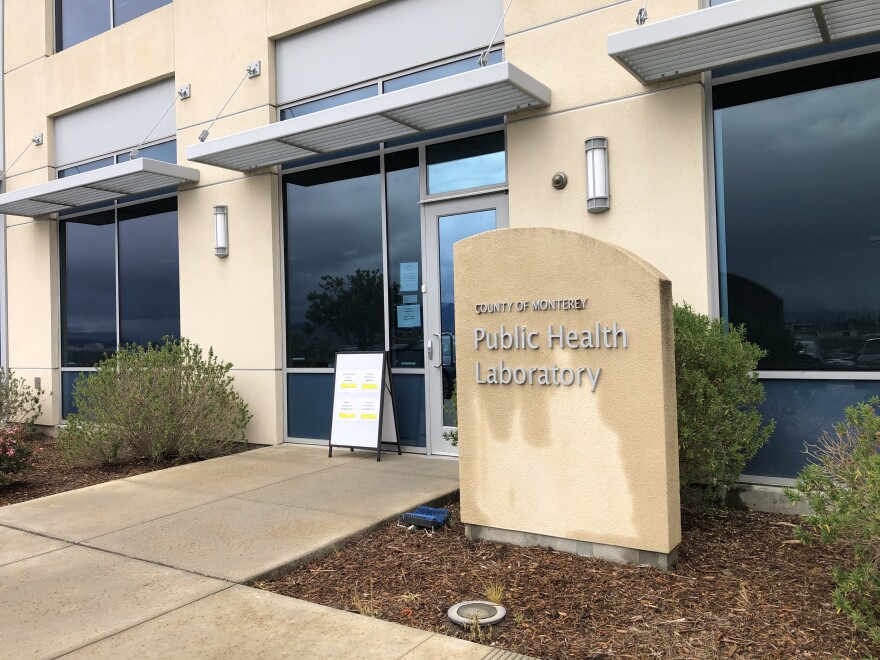The Monterey County Public Health Laboratory is testing for COVID-19 seven days a week. And they are finding positive cases in the county. KAZU got a tour of the facility, and found out about the challenges the state-run lab is facing.
Sarah Riddick, Carlos Anaya and Rawni Lunsford have had very few days off in the last month. They are the three public health microbiologists doing all the COVID-19 testing for Monterey County. And they are the only ones who can do this job.
“I am concerned that if one of my staff becomes ill, I have nobody to replace that person with," said Dr. Donna Ferguson. She oversees the microbiologists and is the director of the county’s public health laboratory.
She’s anxious about staff burnout, which she says we are starting to see after several weeks of testing across the country.
“I may have to rely on a local neighboring public health lab to assist with testing. Some of the local public health labs are doing that now,” said Ferguson.

Ferguson could step in if one of her staff is unable to test, but she hasn’t done testing in years and she would have to demonstrate competency, a federal requirement.
Plus, she has a lab to run. And staffing isn’t the only challenge she's managing right now. She’s also working to make sure they have all the chemicals, instruments and supplies needed to do the COVID-19 testing.
“What happened initially was that labs were getting partial orders fulfilled. And other items were being quickly ordered by commercial laboratories that were developing their own version of the test kits and that caused a further backlog,” said Ferguson.
Ferguson took me on a tour of the lab, which works mainly to identify agents that cause infectious disease.

They work on tuberculosis, hepatitis and measles outbreaks; outbreaks you don’t always hear about on the news, Ferguson said.
“This is our main laboratory where we receive specimens for COVID testing. Our laboratory is a combined environmental and clinical lab. So in addition to testing for things like COVID, we also test water for the public here in Monterey County."
The lab is filled with computer terminals, refrigerators storing vials, and machines that can extract a virus from a nasal or oral swab.
Ferguson then takes me to see the biosafety level three rooms (BSL-3). They are the only ones in Monterey County, and that’s where the COVID-19 testing is happening.
“Give you a peek through our special isolation rooms,” Ferguson said.

We peer through the glass door where the microbiologists in white labs coats are working hard.
“These rooms have negative pressure. So that means that when I open this door, the contamination stays in the room,” said Ferguson.
Monterey County Public Health Laboratory has been testing for COVID-19 since March 6. Before that, they were sending specimens to the CDC and other labs.
So far they have tested at least 158 specimens and they plan to continue testing in the coming days.

But, they are potentially facing a shortage of the chemicals they need to carry out the tests. If they run out, they’ll have to stop testing altogether.
Ferguson says from the time they receive a specimen, they can complete a COVID-19 test in about three to four hours.
“However, patients may not get the results in three to four hours just because we have to go through a system of reporting,” said Ferguson.
An outbreak like COVID-19 puts into focus the importance of public health laboratories, but Ferguson is fearful that once the outbreak has been brought under control, society will once again develop what she calls global amnesia.
“Every time we have an incidence like this, whether it was SARS or MERS, there's this support for public health labs for about a year or two. And then people have, you know, I heard one doctor call it "global amnesia." They forget about it. And then the funding is reduced,” said Ferguson.
She says in the 1970s there were about 40 local public health labs in California. Since then, 10 have closed, including one in Santa Cruz County. Without a lab, the county is now sending their specimens to Santa Clara County.
Monterey County has been doing testing for San Benito County.
Despite the challenges she is facing, Ferguson is optimistic about COVID-19 testing.
“The good news is we heard yesterday that the commercial labs, the big ones across the country, Quest and Labcorp, now have two different methods than the CDC method that they're able to offer,” said Ferguson.
Ferguson says these labs can perform thousands of tests per day. That takes a little pressure off her lab because it means she can continue to focus on testing the most susceptible populations - -the elderly, first responders and the homeless.



